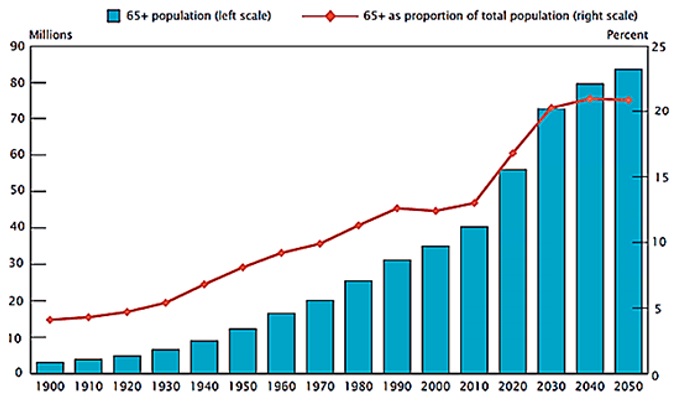
Should You Designate a Trusted Contact?
Significant changes in demographics are transforming generations in the United States. According to the U.S. Census Bureau, one in every five Americans will be 65 years old by the year 2030; the Baby Boomers are making big waves yet again.
Population Aged 65 and Over: 1900 to 2050

Protecting boomers as they journey into this new chapter of life is a top priority of financial advisory firms, and for good reason. According to the Securities Industry and Financial Markets Association, U.S. seniors lose an estimated $2.9 billion every year in cases of financial exploitation, with only 1 in 44 cases reported to authorities. This trend is increasing at a measurable clip.
Suspicious activity report filings in elder exploitation cases quadrupled from 2013 to 2017. Of these filings, 80% involved a monetary loss.
As these statistics continue to gain momentum, Charter Oak and its partners, including Fidelity, are designing new policies to safeguard its clients. These new policies take many forms, most recently with the ability to add trusted contacts to investment accounts.
Our goal in this communication is to discuss a new resource available to help those who may potentially become vulnerable to financial exploitation or diminished capacity. We will also provide examples of situations or “red flags”; please share this information with family and friends who may find it valuable.
A Trusted Contact is someone designated by you to become a point of contact for your advisor to get in touch with in the event there are concerns about things like your health, well-being, or potential exploitation.
To be clear, you are not required to add a trusted contact to your account, but it is something we offer to those who are interested.
Naming a Trusted Contact is different from naming a person with Power of Attorney (POA). Trusted Contacts do not act on behalf of a client. They are unable to view private account information (balances, performance), execute transactions, or inquire about account activity unless they are also named as an authorized party.
Who can be a Trusted Contact?
Anyone who is at least 18 years old can be a Trusted Contact. Best practice is to designate someone who isn’t already authorized to conduct business or receive information on your behalf. Trusted Contacts are usually family members or close friends (people you can trust and who are likely to know and understand your current situation) as opposed to investment advisors or someone with Power of Attorney (POA).
Having both a Trusted Contact and a person with POA is important because, sadly, 90% of elder abusers are family members or people who are closest to the victim. Lastly, it is important to update this information should and when any circumstances change.
In either case, we recommend you tell the person they are designated as your trusted advisor, so they are prepared in the event they are contacted.
Identifying “Red Flags”
Below is a list of common red flags we encourage people to be mindful of and act accordingly in the event they recognize them in a loved one.
- Sudden changes in habits, such as uncharacteristic cash withdrawals or wire transfers
- Reliance on a new friend or relative who shows excessive interest in their account
- Changes to authorization, POA, beneficiaries, and trusts
- Memory loss, confusion, or difficulty speaking or communicating
If you suspect exploitation or diminished capacity with one of your loved ones, Charter Oak can help.
In closing, we would like to share three main takeaways from this communication:
- Consider adding a trusted contact to your account(s) or for anyone you provide care. This can be done with investment accounts managed by Charter Oak and to bank accounts, including checking and savings. In addition to adding a trusted contact, we believe it important to consider crafting a Power of Attorney as an additional resource.
- We encourage folks to be mindful of the list of “red flag” events that may require subsequent action.
- We recommend reviewing and updating these resources on a scheduled basis or when there has been a life event.
Thank you for the opportunity to manage wealth for you, your family and for those you care for. Please feel free to share this information with anyone who may find it of value and do not hesitate to contact your advisor to continue this dialogue. It is always a pleasure to help.
